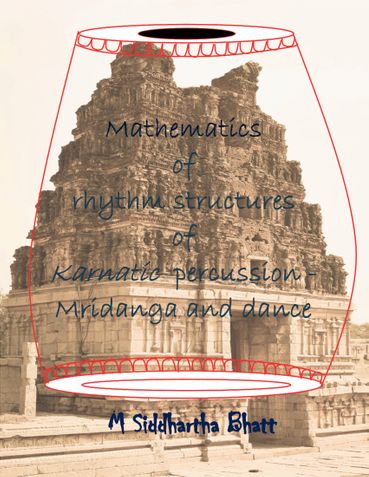Ratings & Reviews
Re: Mathematics of rhythm structures of Karnatic percussion- mridanga and dance (eBook)
This book ( Mathematics of Karnatic percussion-Mridanga and Mance ) is indeed an exemplary exposition of Mathematics and Physics of Mrudanga.
The fundamentals of the percussion instrument in relation to the sequence structure as well as the details relating to the basic 'strings' of percussion instrument are very convincingly brought out. Starting from the materials and the design of the Mrudanga, synchronization of the Mrudanga pitch with the ensemble intonations, details of treble drum head, musical metering of the talas, basic jatis from which the talas have evolved, differences of the jati of nadai's , phase difference between the tala cycle and the sahitya, as well as the subtleties such as the location of the pause in a Raga-Tala-Pallavi(RTP) have been effectively conveyed. The description of the tala clapping speed has been brought out in fine detail in mathematical terms as well as descriptive language.
The intricacies in the rendering of the Mohras ( that precede the Mukthyas) as well as the significance/nuances of the Mukthayas which indicate intermittent or final terminations in relation to the rendering context has been wonderfully brought out. The axial and radial symmetry of the adi tala has been very well explained and is a pleasure to read.
Only a person who has complete command of the 'Science and Art' can present the tala structures of the 35 talas or for that matter bring out the nice explanation applicable to percussion instruments by using the analogy of engine speed to automobile speed comparison.
I feel privileged to read this book.
I recommend it to learners as well as advanced practitioners of percussion instruments.
Dayananda
Mathematics of rhythm structures of Karnatic percussion- mridanga and dance (eBook)
At the outset I would say it is a well-researched and comprehensive book on Mridanga in English.
Each chapter is a gem in itself. The book is like a beautiful necklace with all chapters well amalgamated. Each chapter is well written in an easy language flow such that everyone can understand the concepts.
The Chapters on Mohras and Mukthayas are original. I have not come across any other book or paper on these topics with such a clarity. The mathematical aspects are brought out nicely but requires detailed study to understand the structures explained through mathematical equations. Music fraternity with mathematical background would love this particular chapter. For rest of the people, frankly the mathematics becomes tough at certain places but it can be skipped without losing the overall flow.
The pricing of the book is very nominal. In overview, I recommend the book for both learners and serious readers of Mridanga and dance pertaining to Carnatic Music.
Re: Mathematics of rhythm structures of Karnatic percussion- mridanga and dance (eBook)
This is a good original book on the performing art of the mridangam. The introductory portion contains a nice compilation of the historical aspects and the list of famous mridangam vidwans over the last 60-80 years. There is also a chapter on the physics of the mridangam and another one on tala and musical metering.
The main portions of the book are the Mohras (per-termination sequences) and Mukthayas (terminating sequences) contain a lot of material on structural aspects which is original and unique. The author has gone into great depth to explain the arithmetical and algebraic structure of the Mohrs and Mukthayas. There is also a chapter on solo play or tani avartana.
In some places it appears that the author is struggling to explain the concept but on subsequent reading the concepts become clear. This is quite natural while bringing out the tacit aspects on paper.
The book is marked by total clarity on the different terminologies such as jati , nadai, etc.
The book is useful to learners as well as advanced proponents of the art. I recommend the book for all carnatic percussionists. Being an e-book it saves on paper, trees and the environment. It is cheaply priced and affordable by one and all.

 Verified Buyer
Verified Buyer
Re: Mathematics of rhythm structures of Karnatic percussion- mridanga and dance (2nd Revised Edition) (eBook)
This book brings out for the first time the mathematical structures of various entities employed in Carnatic music such as nadai, akshara jati, kalam, etc.
The author has given a lot of emphasis on the maths of calculating of the starting point of complex sequences as it is evident from its mention in many chapters. This is a highly neglected subject and has probably never been discussed in any other paper before. The author has quantified the starting point of long mohrams and mukthayams under many nadai changes and eduppus. Another interesting aspect of this book is that the author has given mathematical formulae for calculating the size of mohras for the entire suladi saptha talam system. He has also attempted to evolve methods for online computing of the mukthayams. He has discussed at length about srutis and their matching which is normally ignored in mridangam books[TS1] . I am sure that this book will be useful to both learners as well as to advanced students of mridangam, Karnatic music, dance and even other percussion instruments.